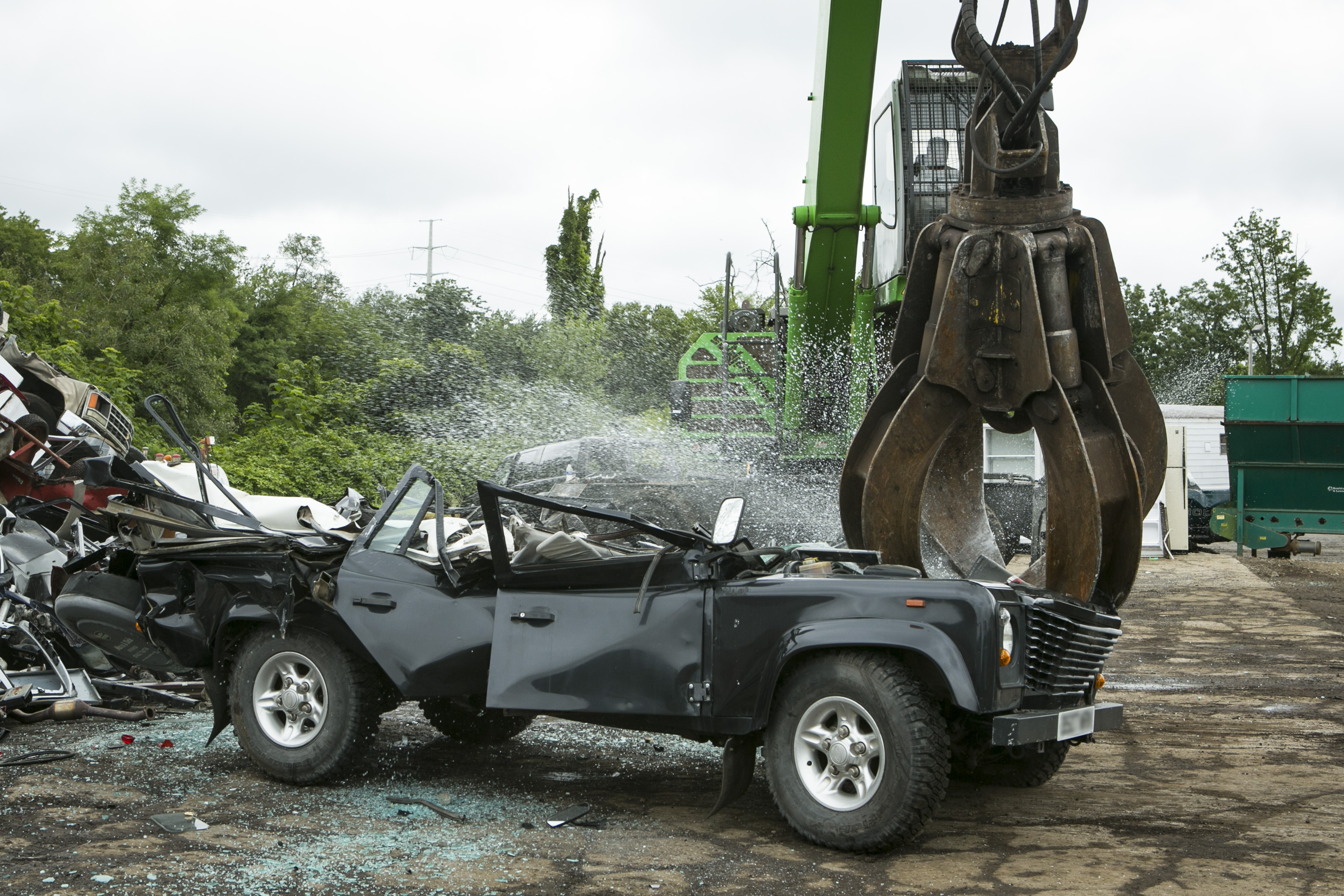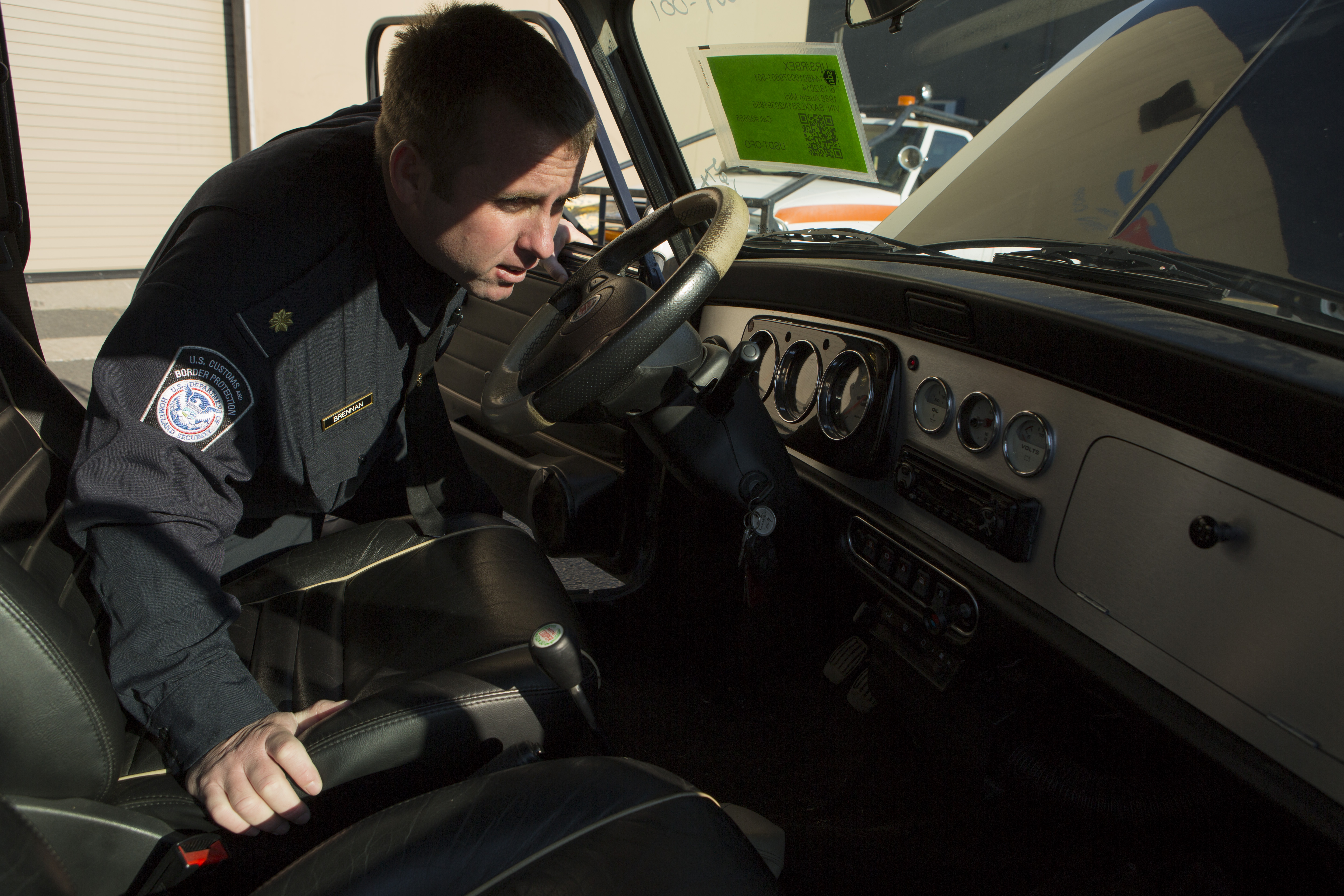
Collaboration Crushes Trade Fraud
A fter routinely targeting a car import for inspection, a U.S. Customs and Border Protection international trade specialist noticed an unusual cat-and-mouse move: The importer did not process the targeted vehicle for U.S. entry and shipped the car, a Land Rover Defender, right back to England where it had originated.
The CBP international trade specialist countered the importer’s move by contacting the CBP attaché in London, who in turn gave a heads-up to U.K. law-enforcement colleagues to look at the vehicle when it arrived in port. The CBP international trade specialist’s instincts were spot-on – upon inspection, the British authorities found that the vehicle identification number, or VIN, had been manipulated, indicating fraud and that the vehicle was assembled with stolen parts.
The Brits were intrigued. Recent thefts had been high for Defenders, a model of Land Rover not made for the U.S. market because Defenders don’t meet U.S. safety or emission standards. If talking with the Americans about illegal vehicle shipments would cut down on U.K. crime, they were all for it.
This one seizure in June 2013 kicked off discussions between the U.S. and U.K. on how to establish a formal information-sharing relationship. After the two countries officially agreed to a letter of intent, Operation Atlantic began in April 2014.
C ollaboration to prevent illegal international commerce is nothing new to CBP and other federal agencies working side by side at the Commercial Targeting and Analysis Center. Since 2009 the 11 CTAC agency partners have learned that by sharing information on manufacturers and shippers of suspect goods – ranging from toys to food to electronics and more – they have a better chance of shutting down the pipeline of unsafe or illegal goods. The rest of the world has noticed too. The World Customs Organization in 2014 named CTAC a best practice for governments.
When it came to working with the British to clamp down on the import of fraudulently manipulated vehicles, several CTAC member agencies were raring to go. The National Highway Traffic Safety Administration, the Environmental Protection Agency and Immigration and Customs Enforcement were immediately onboard with CBP. In fact, NHTSA first requested that CTAC target Land Rover Defenders because of the potential safety problems with vehicle imports that don’t meet U.S. certification requirements, among them standards for seatbelts, crash endurance, airbags and lighting.
The reason that people go to elaborate efforts to manipulate imported vehicles comes down to legal requirements. Vehicles fewer than 25 years old “need to conform with federal motor vehicle safety standards and need to meet EPA standards for emission controls and the Clean Air Act,” said Chris Polashock, CBP supervisory import specialist for the port of Newark, New Jersey. Vehicles that are more than 25 years old are exempt from the safety standards; those more than 21 years old are exempt from EPA requirements. But vehicles at least 21 years old with replacement engines aren’t exempted by EPA unless they contain equivalent or newer EPA-certified engines.
Importers try to take advantage of these rules. Hence a Mini Cooper with a 2003 chassis and a 1999 engine may have a 1988 VIN plate under the hood. The older VIN gives the appearance the vehicle is more than 25 years old and legal for import.

“There could be parts on there that are stolen, there could be parts that are not legal,” said Gordon Roberts, detective chief inspector with the U.K. Association of Chief Police Officers Vehicle Crime Intelligence Service. Such seized vehicles of unknown origin, full of parts cannibalized from other cars, are “a blight to road users” in the U.S. and U.K., said Roberts. With such a suspect provenance, the cars and their parts can’t be resold domestically or overseas. The only lawful destiny remaining for these cars is their destruction and use as scrap.
Seeing the crushing of such highly desirable cars via media reports can enflame car enthusiasts who don’t understand how hazardous such cars can be on the road. “We’re looking particularly at the Austin Mini and the Land Rover Defender,” said Brenda B. Smith, assistant commissioner for the CBP Office of International Trade. “They’re very attractive and valuable cars to be brought into the U.S., but we’re seeing a lot of problems with them.”
The U.S. and U.K. agencies are educating the car buff communities about the dangers of these vehicles. “We’ve worked closely with our colleagues at the Department of Transportation as well as colleagues from overseas in the U.K.,” said Smith, who are “ensuring that vehicles leaving their country and coming to the U.S. are safe for American citizens.”
O ver take-out cups of coffee around a Washington, D.C., conference table in early December 2014, U.K. and U.S. representatives of Operation Atlantic swapped information in person for the first time. They talked about the status of current information-sharing and looked at new targeting tactics for 2015 to further crack down on illegal vehicle imports.
In its 10 months in action, Operation Atlantic’s binational working relationships have stopped criminal activity in both countries. CBP’s Container Security Initiative staff stationed at the U.K. ports of Felixstowe and Southampton regularly work with their British counterparts. Using CBP targeting protocols, CSI personnel identify containers that pose a potential terrorism risk. They then alert British authorities, who inspect the vehicles and vet the VINs through U.K. and European stolen-vehicle databases before they are placed on U.S.-bound vessels. This can net vehicles that have been manipulated, stolen or otherwise illegally exported.
Alternatively, U.K. officials will alert their U.S. Operation Atlantic colleagues to inspect upon arrival a questionable vehicle already en route to the U.S. Both teams share information about suspected companies or individuals in frequent conference calls and emails.
This formalized data sharing is different from the collaboration among U.S. federal agencies. The U.K. doesn’t have access to U.S. databases. This reinforces the importance of cooperation and routine conversations between the U.S. and U.K. partners on the people and businesses that deal in illegal goods.
Collaboration between CTAC and the U.K. Border Force makes perfect sense to Tim Coward, national container targeting manager for the U.K. Border Force Intelligence Directorate. The Border Force controls immigration and customs for people and goods entering the U.K. Coward said that the reason for his unit is “preventing and detecting vehicle crime.”
“We need your suspect importer information,” said Coward, “and you need our suspect exporter data.”
“Take your data and our data, put the two together and our targeters can really drill down on how they’re getting the cars out,” agreed Acting Detective Sergeant Nick Shrubshall of the U.K. Association of Chief Police Officers Vehicle Crime Intelligence Service.
The American and British partners around the table discussed how to thwart a recent trend among the law-breaking exporters: dismantling vehicles and shipping them as parts. “It’s a growth area of business,” said the U.K.’s Gordon Roberts, “chopping the vehicles and putting them in various crates for U.S. export.”
Importing a vehicle in parts – then manifesting the shipment as “parts” or even “scrap” – and reassembling it upon its U.S. arrival is illegal. Shippers try to avoid detection by sending disassembled vehicles in multiple shipments, from different ports or from different companies. By sharing what they learn about the criminals’ operations, the Operation Atlantic team better targets and counters the illegal activity on both sides of the ocean.
The operation has “had interventions with $1 million worth of vehicles,” said Roberts, “but arrests have been made in the United Kingdom and people have been dealt with in the criminal justice process for altering the identity of these vehicles.”
Roberts said that the criminal profits from international vehicle crime “will be funding drug abuse, it will be funding all aspects of criminality within our society.” He added that our countries’ working partnership “could only be a good thing for international law enforcement, tackling motor vehicle crime together.”
CBP is exploring similar trade enforcement partnerships with other countries. The key to expanding such cooperation internationally lies in disrupting trade in products that harm other countries economically and risk their public health and safety. “We’re actively pursuing engagement with foreign customs services and regulatory agencies to leverage the collective expertise of the CTAC, as well as to launch specific operations that combat a shared import safety risk,” said Ed Ryan, supervisory international trade specialist in CBP’s Office of International Trade. “The more we’re able to jointly target with other nations, the greater success we’ll have at shutting down manufacturers that ship products that violate our laws.”
F or U.S. residents interested in importing a car or in purchasing a model not usually certified for U.S. use, the possibility of the government seizing and destroying their imported vehicle may set off alarms. Consumers can better protect themselves from fraud by researching the vehicle and seller before buying.
CBP has tips for importers and exporters navigating federal regulations for the first time. NHTSA’s easy-to-follow frequently asked questions webpage guides purchasers to helpful information. For example, when considering a specific import vehicle, look for the NHTSA certification label on the vehicle, usually on the door or door frame on the driver’s side.
CBP urges prospective buyers of imported vehicles to confirm the vehicle’s validity by checking the VIN in a vehicle history report. If a vehicle is suspected of being illegally imported into the U.S., report it at CBP’s e-Allegations website, which will allow you to confidentially submit information.
The EPA also details steps to ensure purchasers are getting an import that meets emission standards. EPA’s regulations governing non-U.S.-version vehicle imports date to the 1972 Clean Air Act.
All the U.S. agency partners warn buyers to beware and research the vehicle and importer or seller before ponying up money. “None of us wants consumers to lose money and none of us takes pleasure in destroying vehicles,” said CBP’s Ed Ryan, “but we have to do all we can to protect the U.S. economy and keep unsafe vehicles off our roads.”


